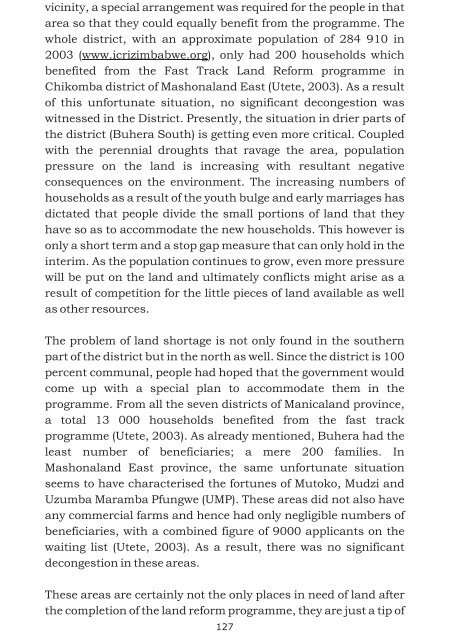Beneficiaries are actors too.pdf - Southern Institute of Peace ...
Beneficiaries are actors too.pdf - Southern Institute of Peace ...
Beneficiaries are actors too.pdf - Southern Institute of Peace ...
Create successful ePaper yourself
Turn your PDF publications into a flip-book with our unique Google optimized e-Paper software.
vicinity, a special arrangement was required for the people in that<br />
<strong>are</strong>a so that they could equally benefit from the programme. The<br />
whole district, with an approximate population <strong>of</strong> 284 910 in<br />
2003 ( www.icrizimbabwe.org),<br />
only had 200 households which<br />
benefited from the Fast Track Land Reform programme in<br />
Chikomba district <strong>of</strong> Mashonaland East (Utete, 2003). As a result<br />
<strong>of</strong> this unfortunate situation, no significant decongestion was<br />
witnessed in the District. Presently, the situation in drier parts <strong>of</strong><br />
the district (Buhera South) is getting even more critical. Coupled<br />
with the perennial droughts that ravage the <strong>are</strong>a, population<br />
pressure on the land is increasing with resultant negative<br />
consequences on the environment. The increasing numbers <strong>of</strong><br />
households as a result <strong>of</strong> the youth bulge and early marriages has<br />
dictated that people divide the small portions <strong>of</strong> land that they<br />
have so as to accommodate the new households. This however is<br />
only a short term and a stop gap measure that can only hold in the<br />
interim. As the population continues to grow, even more pressure<br />
will be put on the land and ultimately conflicts might arise as a<br />
result <strong>of</strong> competition for the little pieces <strong>of</strong> land available as well<br />
as other resources.<br />
The problem <strong>of</strong> land shortage is not only found in the southern<br />
part <strong>of</strong> the district but in the north as well. Since the district is 100<br />
percent communal, people had hoped that the government would<br />
come up with a special plan to accommodate them in the<br />
programme. From all the seven districts <strong>of</strong> Manicaland province,<br />
a total 13 000 households benefited from the fast track<br />
programme (Utete, 2003). As already mentioned, Buhera had the<br />
least number <strong>of</strong> beneficiaries; a mere 200 families. In<br />
Mashonaland East province, the same unfortunate situation<br />
seems to have characterised the fortunes <strong>of</strong> Mutoko, Mudzi and<br />
Uzumba Maramba Pfungwe (UMP). These <strong>are</strong>as did not also have<br />
any commercial farms and hence had only negligible numbers <strong>of</strong><br />
beneficiaries, with a combined figure <strong>of</strong> 9000 applicants on the<br />
waiting list (Utete, 2003). As a result, there was no significant<br />
decongestion in these <strong>are</strong>as.<br />
These <strong>are</strong>as <strong>are</strong> certainly not the only places in need <strong>of</strong> land after<br />
the completion <strong>of</strong> the land reform programme, they <strong>are</strong> just a tip <strong>of</strong><br />
127


